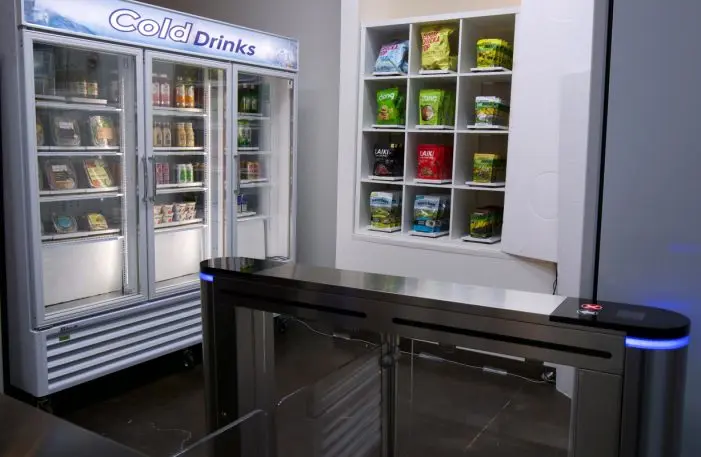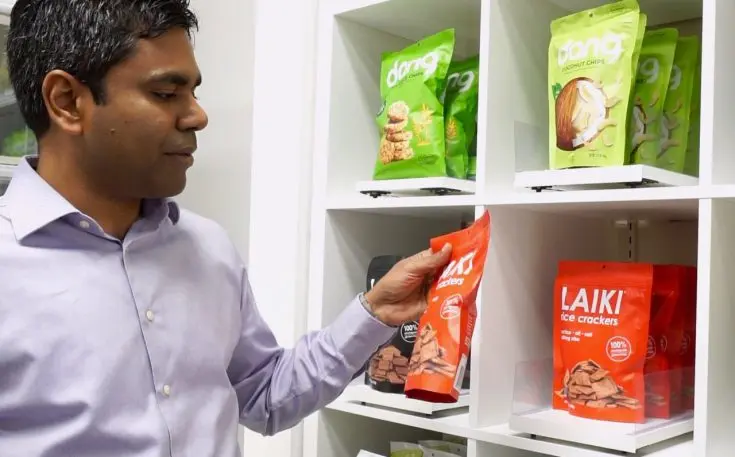Amazon Go, the cashier-less convenience store that uses sensors and AI to automatically track and ring up purchases, set off a surge of interest when it was teased in 2016 and finally opened in Seattle this past January. But the idea of automated checkout goes back well before Amazon Go’s launch. As the accuracy of computer vision has taken off in the past few years, turning checkout over to cameras and AI has become the focus of several startups.
“As soon as I stepped in the store, I saw the lines, and I knew there was no way I was going to go in for one item,” says entrepreneur Krishna Motukuri, recalling an aborted 2014 trip to Trader Joe’s to pick up milk. “That got me thinking, there’s gotta be a better way.” Motukuri actually worked at Amazon from 1999 to 2006, in supply chain systems and product search. (He declines to say whether anything like the Amazon Go model was discussed when he worked there.)
In 2014, Motukuri teamed up with his college buddy Motilal Agrawal, who has a PhD in computer vision, to develop a product-tracking technology company. Taking several twists and turns, their efforts led to the automated store venture they just recently christened as Zippin.
Motukuri and I are sitting at a plain table in the back of a gutted retail space at Howard and Fremont streets in the East Cut neighborhood of San Francisco, two blocks from the giant new Salesforce Tower. At another table, closer to the front, Agrawal and his team of coders are hunched over their work. And at the very front, hidden from the street behind blanked-out windows and sheets of Styrofoam, is a very mini mart: a few shelves holding snacks and two coolers loaded with drinks, salads, and other grab-and-go fare.

With it, San Francisco gets its first automated checkout market, which will expand up to nearly 500 square feet to become a full-sized cashier-free convenience store in the coming months, says Motukuri. Not only a first for San Francisco, Zippin–as far as we can tell–is the first Amazon Go rival to open to the public anywhere.
Related: Standard Cognition is first Amazon Go rival to unveil deal with stores
It’s far from the only competitor, though. Bay Area neighbors such as AiFi, Aipoly, and Standard Cognition and Israel’s Trigo Vision are all developing similar systems. They each use arrays of inexpensive cameras positioned overhead to track people and the products they pick up. The camera feeds are analyzed by algorithms trained through machine learning to recognize the appearance of each product the store carries.
How it works
Some companies, like Trigo Vision, say they can do the job just with cameras. But Zippin uses weight sensors on the shelves as a backup. Several of the same product, like five bags of potato chips, sit on each sensor, which can register when one of the items has been picked up. “At any given point, when you pick an item off [the shelf] we know that took place from the cameras overhead as well as the [shelf] sensors,” says Motukuri.
(Other automated checkout startups, such as Imagr, mount cameras on smart shopping carts, but they don’t allow people to literally put things in a bag or pocket and just walk out.)
How does the system know whom to charge for what? Shoppers check in through Zippin’s app displaying a QR code on the phone screen for a scanner at the entrance. From there, the overhead cameras follow the shopper, as they pick up items (as well as when they put items back). Seeing that person finally walk out the door, Zippin’s system tallies what they picked up and charges their online account.

Motukuri reckons that a typical convenience store or bodega, covering about 1,000 square feet, would need only about 15 cameras–a startling claim. The inaugural Amazon Go store, measuring about 1,800 square feet, requires hundreds of camera arrays, according to the New York Times. Amazon Go also uses weight sensors on its shelves.
Stores would purchase the gear on their own, though Motukuri says the company can refer customers to installers. The full bill, for cameras, shelves, and installation, will run about $20,000 to $25,000, he estimates. Stores also pay a monthly fee based on square footage and sales volume for Zippin’s image recognition and inventory tracking service—which is how the company makes money.

Related: Two Ex-Googlers Want To Make Bodegas And Mom-And-Pop Corner Stores Obsolete
Motukuri hews to the popular claim that AI will change jobs, rather than eliminate them. “Most people who are standing in one place and scanning the products–doing nothing else–can actually move on to provide better customer service . . . help customers find the product that they need.” (Like rivals, Zippin’s system provides automated inventory tracking for store owners, as well.)

But Zippin’s store is a prototype, meant to showcase the technology for potential clients and investors, not to turn a profit. Zippin is ultimately in the business of selling tech to other people’s stores. The company has so far attracted $3 million in seed investment from Maven Ventures, Core Ventures Group, Pear Ventures, Expansion VC, and Montage Ventures. Motukuri won’t say if the company has inked any deals with stores, or chains of stores, to implement the technology.
Thus Standard Cognition remains the only such automated checkout company to announce an actual deal–to outfit up to 3,000 convenience stores in Japan by summer 2020. Standard Cognition will start with its own demo store in Japan, but not until 2019. So Zippin stands out as the first opportunity for the public to see if anyone other than Amazon can pull off the promise of line-free robo shopping.
This article has been updated.
Recognize your brand’s excellence by applying to this year’s Brands That Matter Awards before the early-rate deadline, May 3.
